- News all the latest
- Theme Park explore the park
- Resort tour the resort
- Future looking forward
- History looking back
- Community and meetups
-
ℹ️ Heads up...
This is a popular topic that is fast moving Guest - before posting, please ensure that you check out the first post in the topic for a quick reminder of guidelines, and importantly a summary of the known facts and information so far. Thanks. - Thread starter MattyH
- Start date
- Favourite Ride
- Voltron Nevera
- Favourite Ride
- Voltron Nevera
- Favourite Ride
- Steel Vengeance
- Favourite Ride
- POTC Disneyland Paris
- Favourite Ride
- Voltron Nevera
- Favourite Ride
- POTC Disneyland Paris
- Favourite Ride
- Nemesis Original
- Favourite Ride
- Voltron Nevera
You are using an out of date browser. It may not display this or other websites correctly.
You should upgrade or use an alternative browser.
You should upgrade or use an alternative browser.
Ride/Park Accidents
Rojo
TS Member
https://www.google.com/amp/s/abcnew...alfunctions-injuries-family/story?id=63286072
Eeek! Good Job Merlin is getting rid of all of their log flumes. Otherwise they would run them without water.
A woman was critically injured and her husband and child were also hurt when a water log ride at a California amusement park malfunctioned and flipped over, throwing them from their seats, officials said.
The incident occurred at Castle Park in Riverside on the Log Ride, which, according to the park's website, features a 48-foot drop.
Riverside Fire Department officials said they were called to the park at 4:37 p.m. and said three members of one family were tossed into the water after something went haywire with the log they were riding in and overturned.
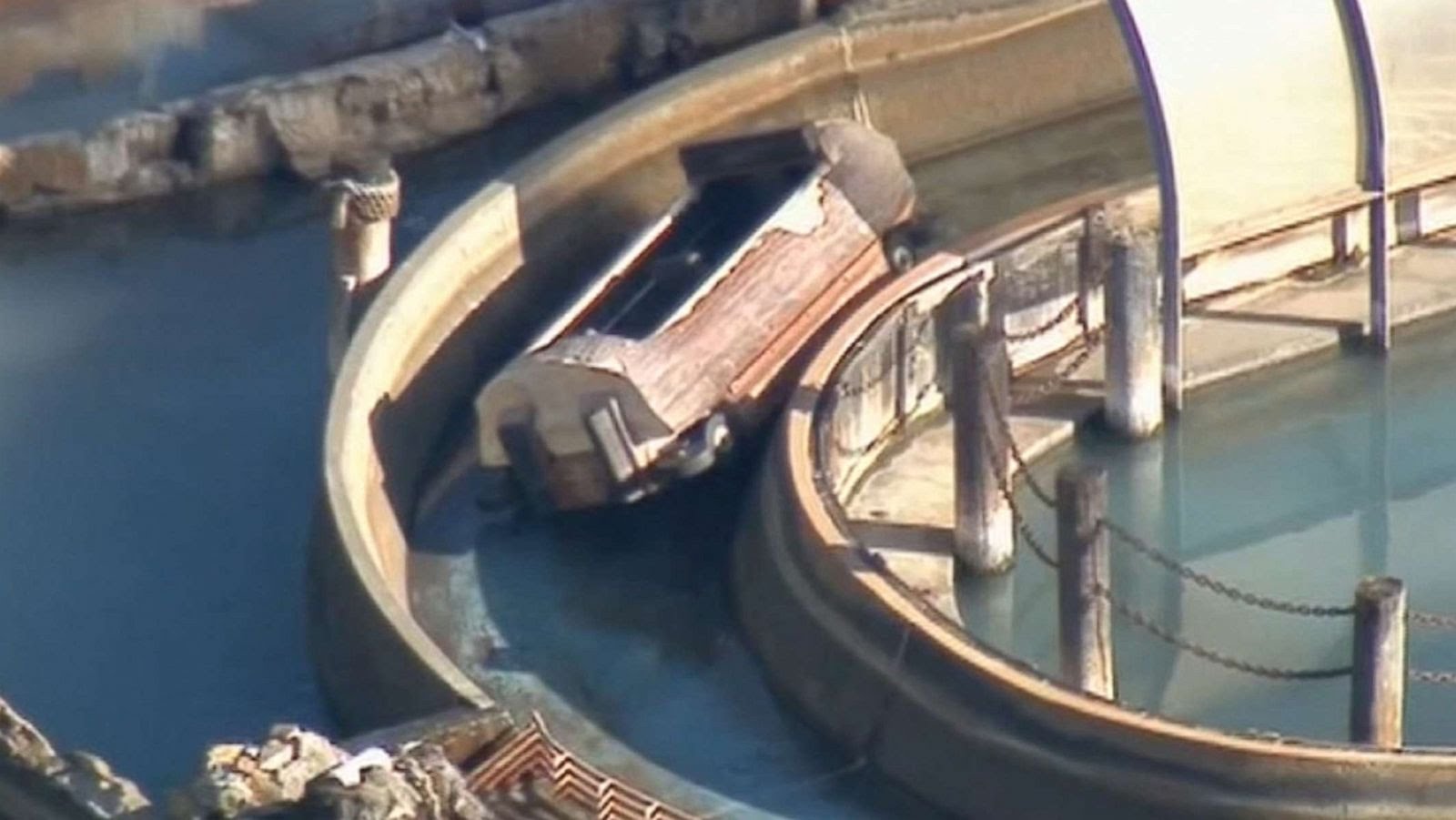
Three people were injured after a log ride overturned at Castle Park in Riverside, Calif., May 25, 2019.
"One of the injuries we categorized as critical. With the two others being minor. All were transported to a hospital," a fire official at the scene told ABC Los Angeles station KABC.
Witnesses said a 10-year-old boy injured in the incident appeared to suffer a cut to his ear and head injuries, while his father suffered scrapes to his arm and back.
The names of the injured family members were not released.
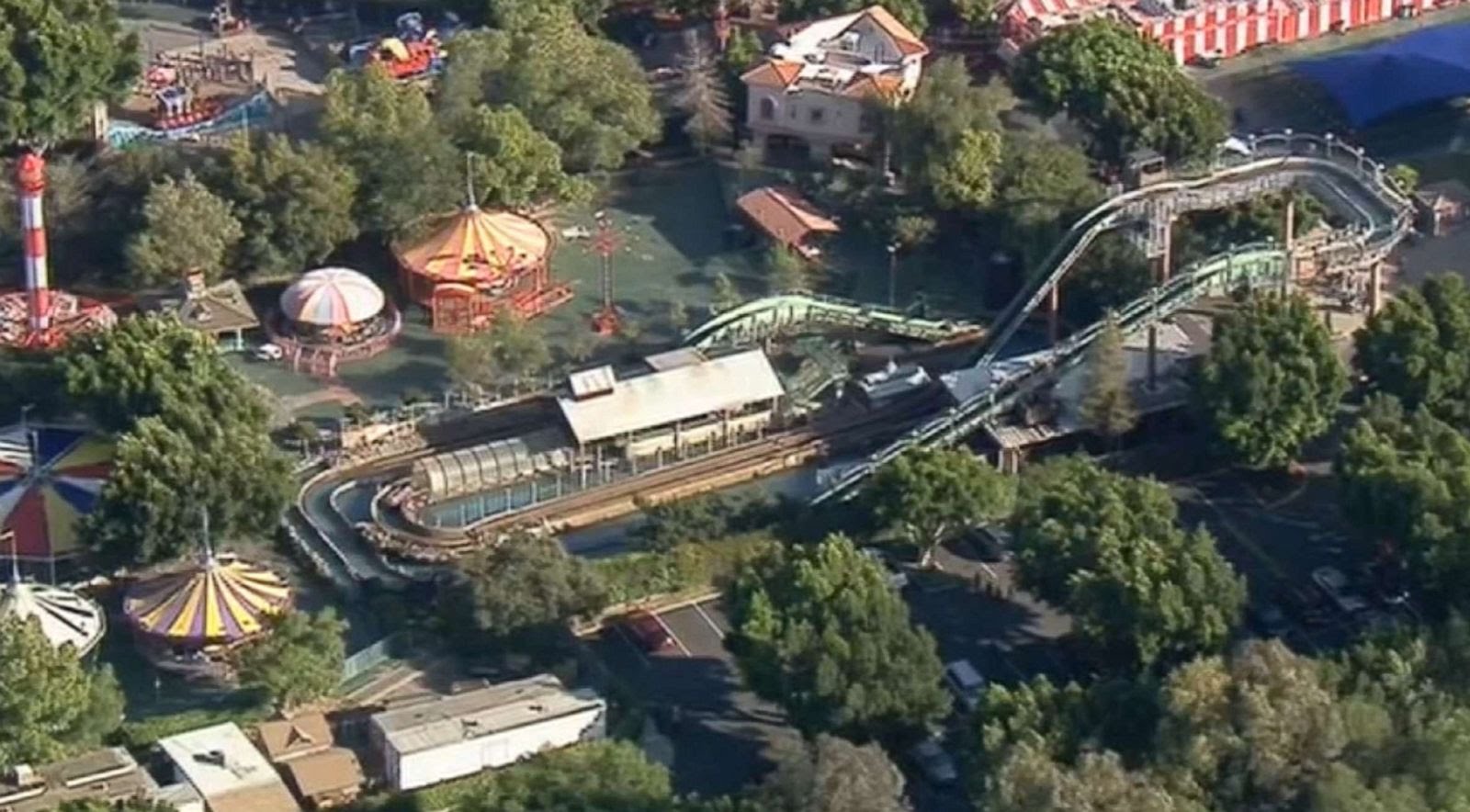
Three people were injured after a log ride overturned at Castle Park in Riverside, Calif., May 25, 2019.
Video of the incident showed the injured boy and his father in the water after the log they were in flipped over.
Fire department officials said a mechanical problem with a ride's water pump apparently caused the accident.
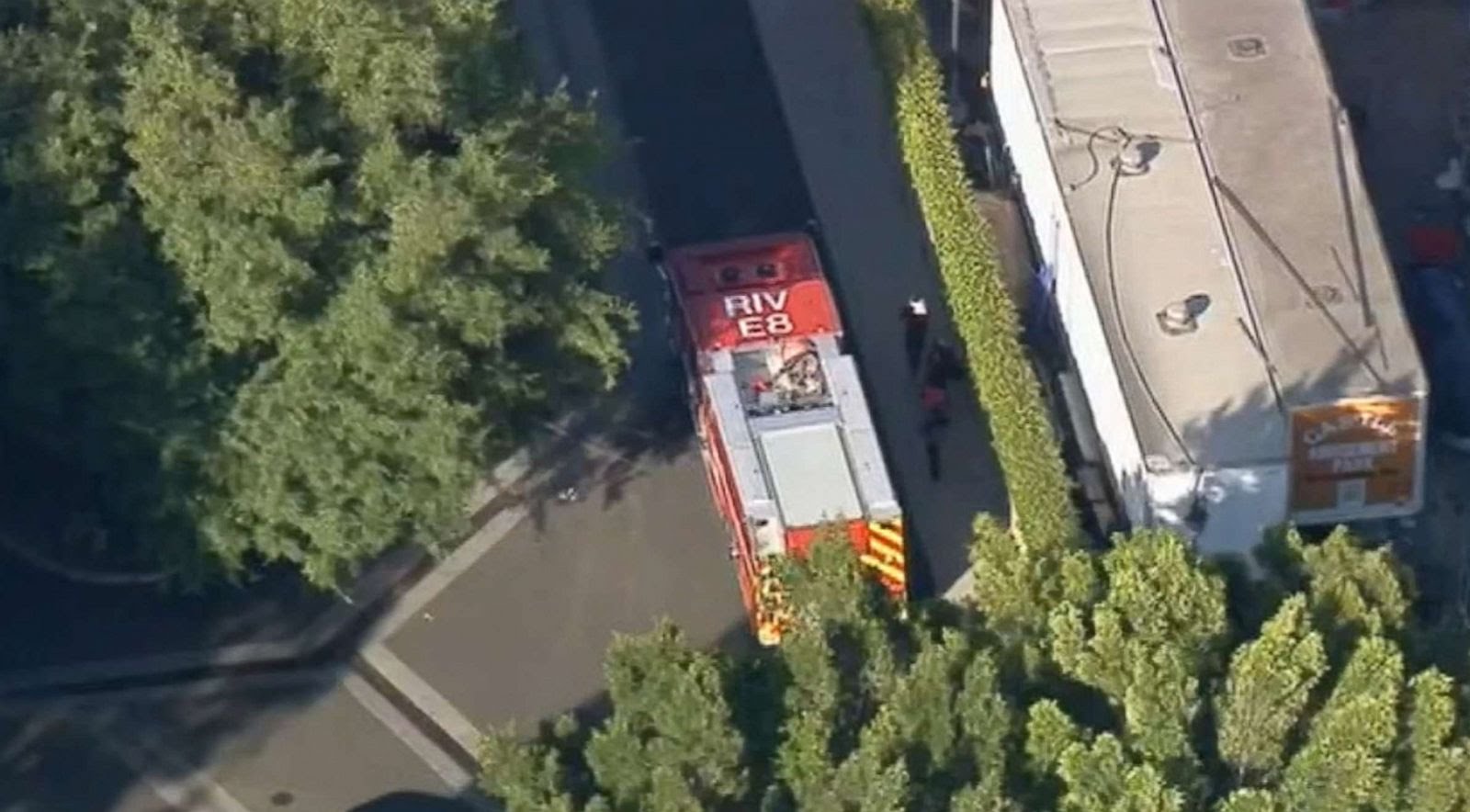
Three people were injured after a log ride overturned at Castle Park in Riverside, Calif., May 25, 2019.
An investigation is underway by the California Department of Health and Safety to determine the exact cause of the malfunction.
The Log Ride was immediately shut down pending the outcome of the probe, officials said.
A spokeswoman for the Castle Park told KABC that the ride had been inspected earlier Saturday and nothing was found wrong.
Eeek! Good Job Merlin is getting rid of all of their log flumes. Otherwise they would run them without water.
Skyscraper
TS Member
Running them without water would actually be dangerous, but I would love to know what caused it.https://www.google.com/amp/s/abcnews.go.com/amp/US/california-amusement-park-ride-log-malfunctions-injuries-family/story?id=63286072
Eeek! Good Job Merlin is getting rid of all of their log flumes. Otherwise they would run them without water.
Rojo
TS Member
Running them without water would actually be dangerous, but I would love to know what caused it.
Totally agree. T'was a joke based on their overreaction to the Rapids and turning off waterfalls
I'm sure all will become clearer soon. Hopelly
Last edited:
Islander
TS Member
What's not easy to see though is how any ride could continue to operate with a faulty pump, or low water level. Both should be (and indeed are on any decent ride system) things that instantly trip the safety circuit and stop the ride...It looks like the answer is hidden in that article, pinning the blame on a faulty water pump. For that to have any bearing it must be too lower water flow causing the log to partially ride along the trough rather than floating in it. Easy to see how a log could flip that way.
pluk
TS Member
What's not easy to see though is how any ride could continue to operate with a faulty pump, or low water level. Both should be (and indeed are on any decent ride system) things that instantly trip the safety circuit and stop the ride...
I suppose the shut down of any water ride can never be instantaneous; the water already in the ride will keep things moving until the trough empties even after an e stop.
There was a similar incident on Brighton Pier (I think, certainly a UK pier log flume) a few years ago, log descended into an underfilled trough and crashed into the next corner at speed causing injury, so it certainly can happen.
Skyscraper
TS Member
That was probably the incident at Bridlington, on the Jungle River. I rode it only a couple of weeks before it happend.I suppose the shut down of any water ride can never be instantaneous; the water already in the ride will keep things moving until the trough empties even after an e stop.
There was a similar incident on Brighton Pier (I think, certainly a UK pier log flume) a few years ago, log descended into an underfilled trough and crashed into the next corner at speed causing injury, so it certainly can happen.
John
TS Member
On log flumes the water level would usually be monitored at the drop run outs, so a boat shouldn't be allowed down if there's not enough water. On the 2-drop travelling model, I'd expect both drop run outs to have water level monitoring as the water may be OK at one but not the other.
Level monitoring doesn't necessarily help on rides with long river sections though (either on rapids or flumes) as boats spend such a long time meandering around where they can't be stopped in a controlled manner. I've often wondered whether a boat leaving the station on a typical Intamin rapids would make it all the way round if the power cut out as soon as it left the turntable - a fully loaded boat can scrape the bottom of the channel anyway.
As for draining water quickly, I believe the Rapids at Universal Singapore are designed to do this , though I'm not entirely sure how well that works in practice.
Level monitoring doesn't necessarily help on rides with long river sections though (either on rapids or flumes) as boats spend such a long time meandering around where they can't be stopped in a controlled manner. I've often wondered whether a boat leaving the station on a typical Intamin rapids would make it all the way round if the power cut out as soon as it left the turntable - a fully loaded boat can scrape the bottom of the channel anyway.
As for draining water quickly, I believe the Rapids at Universal Singapore are designed to do this , though I'm not entirely sure how well that works in practice.
DistortAMG
TS Member
It looks like the answer is hidden in that article, pinning the blame on a faulty water pump. For that to have any bearing it must be too lower water flow causing the log to partially ride along the trough rather than floating in it. Easy to see how a log could flip that way.
When the logs go down the drop and into the splashdown, they are fully riding along a set of rails via wheels on the boats. In the case of the splashdown itself, they ride along a set of raised rails either side of the trough and raised from the trough, which progressively goes deeper into the water along the length of the trough. You can see the rails clearly in the photo below extending from the running tracks on the drop itself. It is only after the splashdown section that the boats actually go back to floating within the trough itself. Having a boat go down a drop and just slam into a full body of water at full speed would not only potentially cause whiplash for riders it could flip the boat due to excessive drag on the front of the boat due to the large amount of water slamming into the boat, this is why they run on the wheels on rails in a controlled manner through the slashdown, gradually lowering the boat into the water before coming off the rails altogether. On almost all water rides with a slashdown, you can clearly see when the boat comes off the rails and gains full buoyancy again. They even modeled it in Planet Coaster on the log flume!
The red bit I have marked is where the boats are travelling fully on the wheels of the boat, the orange line is where the boat comes off the rails, gains buoyancy and is free floating again.
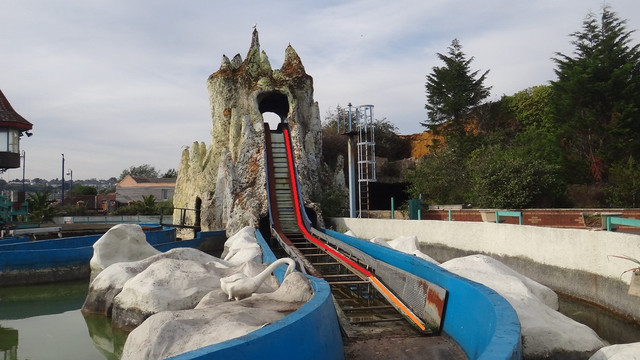
This photo you can clearly see the rails underwater which the boat is riding along, you can also see the side bracing more clearly which stops the boats moving from side to side and extends above the water level each side, they are also visible in the photo above but due to the angle of the photo are less clear.
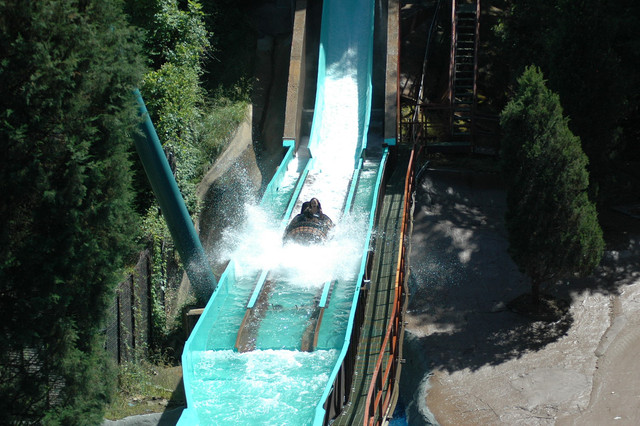
Remember, the boats use wheels to go down the drops and splashdowns, they only float on the trough sections. This is the same for big slash rides like Jurassic Park River Adventure, Valhalla, Storm Force 10 and every log flume like ride in between!
It is completely safe for a boat to stop mid trough if the water level becomes too low as the boat will just rest on its wheels on the trough. Very safe and no issue or risk whatsoever, it is when the water level becomes too low in the splashdown section where it can become an issue and dangerous, as the water usually acts as the only way of slowing the boat down after the drop. (a very few are aided by magnetic brakes but that is a slightly different ride). Having a lower water level means there is not a way to properly slow the boat down. Resulting in it hitting the water after the splash down at a higher level once it leaves the rails and then going into corners faster causing potential capsizing. The only place they really need to monitor water levels is in the splashdowns as that is the only place there is a real risk of something going dangerously wrong. Notice the wheels in the picture below, specifically the running wheels which are used on the rails of the drop and slashdown like can be seen above.
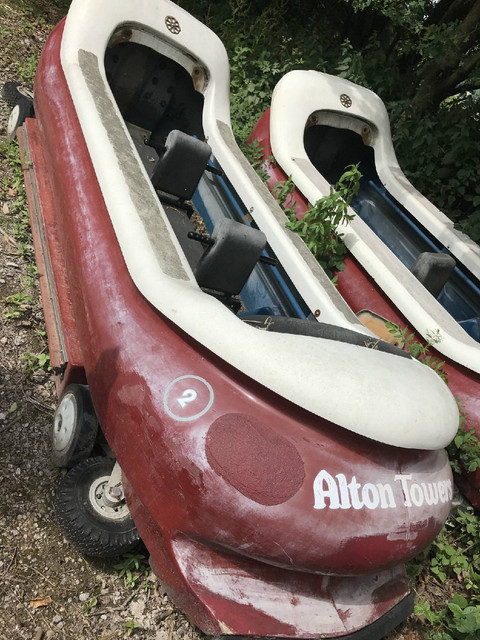
Someone also mentioned above if a rapids boat could make it round after the pumps were switched off, the answer is usually yes, as the boats move at a rate that matches the flowrate of the water, as the water is literally carrying them. So any water already pumped will flow at the same rate as the boats. Although a low water level can put the boats at risk of capsizing due to the pipes strapped to the bottom of a rapids trough to give the ride the rapids. Log rides can have these too, but the obstructions on the channel base are never wider the the wheels axle width on the boats, meaning the boats can go past safely with no obstruction no matter the water level.
One final thing, have you ever noticed how some water log / splash rides can increase or decrease how wet riders get depending on the weather? This is done by lowering or raising the rails in the slash down by a predefined set amount, to increase how quickly or how slowly the rails lower the boat into the water, thus controlling how much of a slash the boat makes. The amount the rail can move is pre defined and set by the manufacturer to a certain tolerance either way, so no matter if the park have it on the dryest or wettest setting there will always be enough water below the boat to bring it to a safe stop. Most log / splash rides do not have this feature but quite a few do, Including Tidal Wave at Thorpe I believe.
Last edited:
Skyscraper
TS Member
An example of a ride which uses brakes is Splash Mountain at the Disney parks. These are known as "run-out brakes" and stop the boat if it goes too fast.
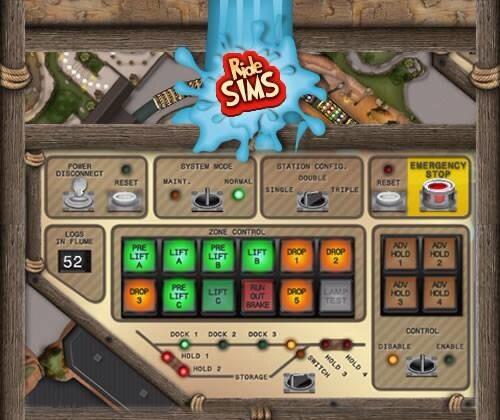
Notice the red button on this SM simulation's control panel.

Notice the red button on this SM simulation's control panel.
Last edited:
DistortAMG
TS Member
I believe the ride is still stopped as I mentioned above with water friction and the boats running on the rails, but they have a small magnetic break just before the boats gain buoyancy again at the end of the splash down to bleed off any remaining speed the boats might have, static magnets working through the principles of eddy currents.
Spark
TS Member
That was probably the incident at Bridlington, on the Jungle River. I rode it only a couple of weeks before it happend.
Is that even still there?
Skyscraper
TS Member
Don't think so.Is that even still there?
Regarding the Twister incident, I read about it this morning. This is frightening because I've ridden it and it really does throw you around. Would love to know how it happened and I hope the lad makes a full recovery.
According to the ITV lunchtime news, His condition is not believed to be life threatening.
https://www.itv.com/news/tyne-tees/...k-after-a-serious-incident-involving-a-child/
https://www.itv.com/news/tyne-tees/...k-after-a-serious-incident-involving-a-child/
Last edited:

